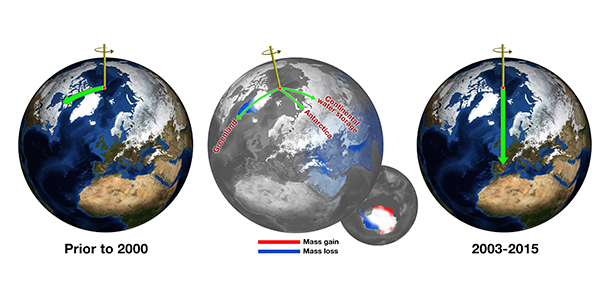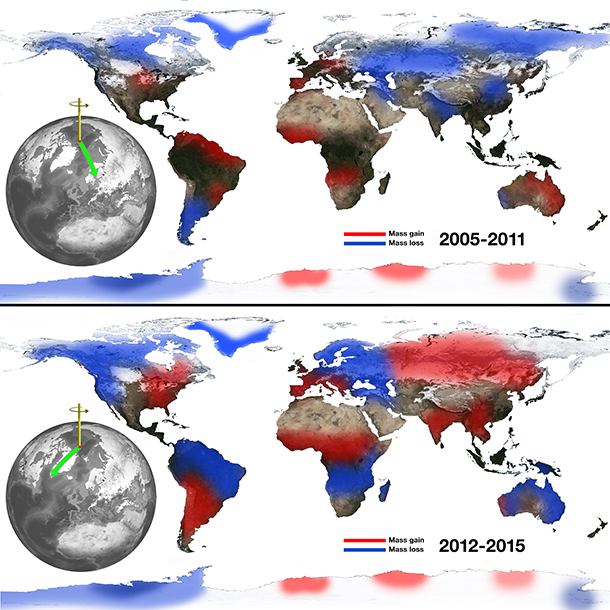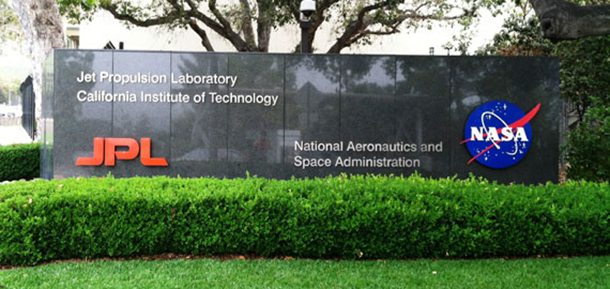I Feel the Earth Move
Air Date: Week of August 19, 2016

Before about 2000, Earth's spin axis was drifting toward Canada (green arrow, left globe). JPL scientists calculated the effect of changes in water mass in different regions (center globe) in pulling the direction of drift eastward and speeding the rate (right globe). (Photo: courtesy of NASA/JPL-Caltech)
Climate change is doing more than melting ice sheets. It’s actually changing the Earth’s rotation. NASA’s Erik Ivins tells host Steve Curwood that the planet resembles a large top wobbling on its axis as the weight of ice lifts, but the wobble has no major effects for humans.
Transcript
CURWOOD: As global warming advances, it’s not just investments that are affected, there are profound effects on our planet as well, with heat waves, melting ice sheets, sea level rise, and changes in rainfall and storm patterns. And a study from NASA published in Science Advances points to an unexpected result of ice in Greenland and the poles melting and running off into the oceans: It’s moving the axis of rotation of the entire planet. This wobbling was first noticed by Jianli Chen of the University of Texas at Austin. And to try to understand this better we spoke with the co-author on the new study, Erik Ivins of the NASA Jet Propulsion Laboratory, in his back yard in Pasadena – welcome to the program!
IVINS: Thank you.
CURWOOD: I have to say I was surprised by the opening statement in your paper. You say the Earth's spin axis has been wandering since the year 2000. How can the axis which is just so fundamental to our planet wander?
IVINS: Actually, we know that it's been wandering for maybe about the last five million years at least, ever since the ice sheet started to build up in northern Canada and in Scandinavia periodically at periods of about a hundred thousand years, and as the ice sheets disappeared they left kind of a depression. It was sitting there. That's a mass deficit with respect to the average Earth and it causes the pole to want to wander in the direction of that little hole that's left there. So we do know that we have been recording the drift in that direction since about 1899 or so, but starting in about 1999 to about 2001 we started to see the Earth start to move in a new direction and that new direction really can only be explained by Greenland ice mass that is lost.

The relationship between continental water mass and the east-west wobble in Earth's spin axis. Losses of water from Eurasia correspond to eastward swings in the general direction of the spin axis (top), and Eurasian gains push the spin axis westward (bottom). (Photo: courtesy of NASA/JPL-Caltech)
CURWOOD: Describe for me exactly what you mean by “the axis is moving”?
IVINS: Well, let's say that you have a toy top and you spin that top. When you start to spin the top, since it's very symmetrical, it will tend to nicely form just a single axis of rotation. But if you were to take a tiny piece of chewing gum and stick it on there, you would find out that this spin axis would slightly tip over. That's because the body is no longer symmetric. It has an off axis piece of mass on it and it's causing the moments of inertia to change. And this is what causes this strange polar motion. Just to give you another analogy: let's say that you were a baseball pitcher and you were frustrated that too many of your hitters were being able to figure out what your pitches were doing. Well, you would use this old technique called "foreign substance", either pine tar or a little bit of your own spit.
CURWOOD: This is not legal. This is not legal...a spitball, doctor!
IVINS: All the hall of famers are spitball pitchers. Now, what they're doing is they're changing the moments of inertia slightly so it changes the entire dynamical character of the pitch as it approaches that batter.

NASA’s Jet Propulsion Laboratory is located at California Institute of Technology in Pasadena. (Photo: courtesy of NASA/JPL-Caltech)
CURWOOD: Makes it wobble and harder to hit.
IVINS: Well, it slightly changes the trajectory because the spin will change, and as the spin changes of course it tends to flutter around a little bit more in the eyes of the batter.
CURWOOD: So you folks are positing that human driven climate change plays a role in this wobble of the Earth’s axis but I understand initially that wasn't your hypothesis. It wasn't what you were looking for. What led you in this direction?
IVINS: Well, we were looking to build a software capability to connect calculations of ice sheet change so that we can project ice loss or gain for a period of about 200 years and try to predict what global warming will do to sea level rise. To improve that situation, we needed to include the Earth's dynamics and the gravitational effects that the ice changes would have on global seas. Then as a way of being able to do a reality check, we looked both that the work that Jianli Chen had done on Greenland and we also looked at the actual raw data that was coming from the international rotation service and we found it was a pretty close match especially when we included the details of Antarctica. And we also decided that it would be interesting to use the Grace mission data that determines how masses are changing on the surface of the Earth to include land hydrology. And once we included land hydrology, we found a near perfect match to the position of the Earth's spin pull.

Dr. Surendra Adhikari and Dr. Erik Ivins of NASA’s Jet Propulsion Laboratory researched how the movement of water around the world contributes to Earth's rotational wobbles. (Photo: courtesy of NASA/JPL-Caltech)
CURWOOD: And who is Jianli Chen?
IVINS: Jianli Chen is a researcher at the University of Texas at Austin. He is also an expert at hydrology and Grace, and he's the first person that really published a very nice paper explaining what the new drift direction was and that the Greenland ice loss was dominating this new direction.
CURWOOD: Wow. By the way, what is Grace? What's the Grace satellite?
IVINS: Grace satellite is a pair of satellites that follow one another and track one another, and they do such a good job of tracking one another with microwaves that they can tell when they either separate and when they get closer to one another. And when they get closer to one another and then separate again they're going over a mass anomaly and they're so sensitive that if there is a change in water underneath them they record that and then map that very, very well.
CURWOOD: This is so interesting. What do you think of the practical effects of the movement of the Earth's axis?
IVINS: There are really none because it is so small. We're suspecting that these changes are occurring at a meter, a meter and a half at the most per year. If you start to get up to about 100 kilometers, then you're changing the amount of solar radiation that's coming into some parts of the Earth so that can only occur and be of significance when we're thousands and thousands of times larger in terms of our scale.

Dr. Erik Ivins co-authored the recent paper, “Climate-driven polar motion: 2003–2015,” published in Science Advances. (Photo: courtesy of the Keck Institute at Caltech)
CURWOOD: So this is a tremendous wake up call, I guess for our civilization that anthropogenic human related climate disruption is actually changing how the Earth is rotating.
IVINS: Yeah, I guess you could say that. I think one of the things that Jianli Chen mentioned was it's just another strange thing that the climate does. It doesn't have a feedback that’s necessarily important for us, but it is just one of those things you can list on that list of "Oh my God! climate change really does that one?” Well, this is yet one of those.
CURWOOD: Erik Ivins is a senior research scientist at Nasa's Jet Propulsion Laboratory in Pasadena. Thanks so much for taking the time with us, Eric.
IVINS: OK, thank you, Steve. It's a pleasure talking to you.
Links
“Climate-driven polar motion: 2003–2015,” in Science Advances
Video: Nasa’s Earth Minute: Greenland Ice
NASA’s Jet Propulsion Laboratory at California Institute of Technology
Living on Earth wants to hear from you!
Living on Earth
62 Calef Highway, Suite 212
Lee, NH 03861
Telephone: 617-287-4121
E-mail: comments@loe.org
Newsletter [Click here]
Donate to Living on Earth!
Living on Earth is an independent media program and relies entirely on contributions from listeners and institutions supporting public service. Please donate now to preserve an independent environmental voice.
NewsletterLiving on Earth offers a weekly delivery of the show's rundown to your mailbox. Sign up for our newsletter today!
 Sailors For The Sea: Be the change you want to sea.
Sailors For The Sea: Be the change you want to sea.
 The Grantham Foundation for the Protection of the Environment: Committed to protecting and improving the health of the global environment.
The Grantham Foundation for the Protection of the Environment: Committed to protecting and improving the health of the global environment.
 Contribute to Living on Earth and receive, as our gift to you, an archival print of one of Mark Seth Lender's extraordinary wildlife photographs. Follow the link to see Mark's current collection of photographs.
Contribute to Living on Earth and receive, as our gift to you, an archival print of one of Mark Seth Lender's extraordinary wildlife photographs. Follow the link to see Mark's current collection of photographs.
 Buy a signed copy of Mark Seth Lender's book Smeagull the Seagull & support Living on Earth
Buy a signed copy of Mark Seth Lender's book Smeagull the Seagull & support Living on Earth

